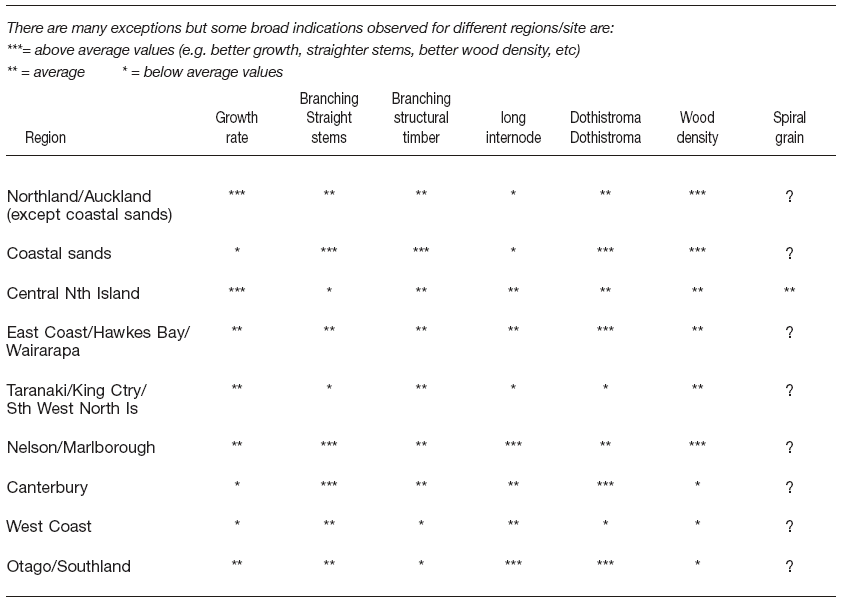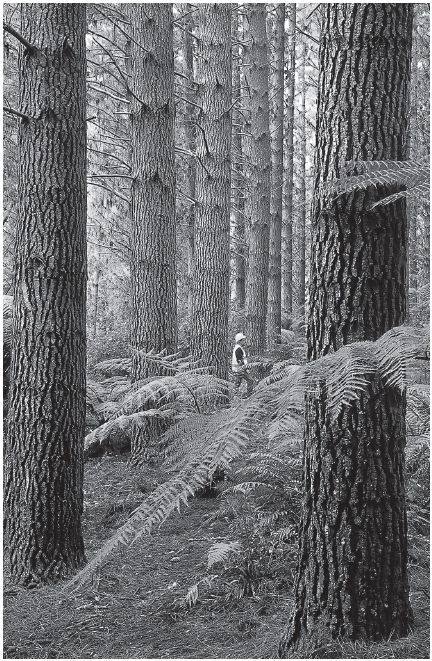The impacts of site, stand management, and genetics to achieve quality
NZFFA Information leaflet No. 10 (2005).
Stands of radiata pine grown on farms usually involve small areas relative to the plantations established by larger forest companies and are often marketed individually, so farm-foresters need to maximise both stand and log quality to obtain the best price at time of harvest. Assuming good stand management and an appropriate silvicultural regime, the quality of a new stand can be further improved by combining the individual trait rating information available through GF Plus™ with a good understanding of the effect of the site or plantation location on these traits.
Site
Some regions or site-types have natural advantages compared to other parts of New Zealand. Obvious examples of this are the fast growth rates achieved by trees on fertile farm sites, and the higher wood density obtained from plantations grown on coastal sands. Other traits will also vary depending on the site-type or region. While there can be many exceptions, some general indications of fairly repeatable region/site differences are:
- Average internode length tends to increase with lower average annual temperature but is generally longest in parts of the Central North Island and in Nelson.
- Wood density decreases from north to south and with increasing altitude (some exceptions are Nelson and coastal sands where wood density is higher).
- Low nitrogen and/or low-rainfall sites tend to have better stem straightness.
- As the average soil fertility level increases, stem straightness, wood density, and spiral grain values usually reduce (they will need more emphasis).
- Sites with high soil fertility produce a greater proportion of juvenile wood for a given tree size.
- Risk of Dothistroma needle blight is greater in high summer-rainfall (or fogprone) areas and can be a localised problem.
Stand management
Good stand management (silviculture) has a major impact on log quality. Some of the impacts of stand management are:
- Pruning increases butt-log quality, at the expense of somewhat lower per-tree and per-hectare wood volume.
- Branch diameter (knot size) can be controlled by higher stocking in combination with delayed thinning. However, this usually requires a longer rotation to achieve a given log diameter.
- Tighter stocking could mean more chance of Dothistroma infection in areas that are prone to this needle-blight.
- Tighter stocking may reduce wind breakage, but stands could be more prone to windthrow after thinning.
- Increased rotation length decreases the proportion of juvenile wood.
- Use of physiologically-aged cuttings may reduce toppling and improve stem form on fertile-farm sites, but growth-rate could be reduced if the physiological age exceeds 3 to 4 years.
General Indication of Regional Trait Differences for Unimproved Radiata Pine

As the average soil fertility increases, stem straightness, wood density and spiral grain values usually reduce (they will need more emphasis).
Genetics/Seedlot options
Growth rate is important on all sites but sometimes there is a need to tradeoff some growth rate for higher ratings for other traits. Because it takes less time for trees to reach a desired stem diameter on more fertile sites there is likely to be a higher proportion of juvenile wood. Therefore, on these sites more emphasis needs to be placed on increasing wood density (as well as stem straightness) and reducing the incidence of spiral grain, thus improving the characteristics of the juvenile wood.

Most (but not all) improved seedlots are more multinodal than unimproved radiata pine. Highly multinodal trees generally have straighter stems and may be less prone to snow damage. If internodal clear-cuttings are an objective when ordering planting-stock, then strong emphasis should be placed on a low branch trait-rating.
Rather than only using individual trait ratings to overcome limitations of site types and regions, they can also be used to improve stands by building on the natural advantages of a site. For example, on a high-density site, use of a seedlot with a high rating for wood density can allow the grower to target the crop to producing a greater proportion of wood of the highest strength structural grade (F7). As knot size is a major contributor to timber strength the stocking of the stand would need to be sufficiently high to adequately control branch diameter.
If the relative importance of a trait within a region is unknown then that trait rating should be held at the unimproved level (or higher) for the selected seedlot.
As is the case with GF ratings, a high rating for growth does not necessarily mean that the seedlot has either high or low ratings for other traits. Control-pollinated seedlots currently being produced in New Zealand have range of values for the major traits. It is possible to obtain seed (or plants from seed) with both highly improved growth and woodproperty trait ratings. Many (but not all) of these seedlots involve less than five parents.
Reduced genetic diversity
The use of few parents in a seedlot usually means higher gain in the desired traits and increased within-stand uniformity. However, there could possibly be a higher risk through reduced genetic diversity for traits not yet tested or selected for in the breeding programme.
Within a large plantation estate and with a regular annual planting or restocking programme it is relatively easy to maintain genetic diversity (represented by the number of parents). This is done by planting a group of few-parent seedlots in any one year and using seedlots with different parents in subsequent years.
Use of stool-beds for the production of cuttings may mean that it is more economical for nursery managers (but not necessarily desirable for plantation owners wanting genetic diversity) to utilise the same few-parent seedlots over a number of years. However, within a nursery, cutting stool-beds are generally replaced on a revolving 3 to 5 year time frame, so different seedlots can be available each year.
In contrast to large corporate plantations many farm-forestry blocks tend to be small and not part of a regular on-farm annual planting programme. Thus, there is less opportunity to spread any risk there may be from reduced genetic diversity. However, as stated earlier, not all seedlots with desirable trait ratings have few parents, so if they are concerned about maintaining reasonable genetic diversity in their plantations, farmers have the choice of either using these seedlots (with 10 to 20 parents or more) or planting small units of a number of few-parent seedlots in any one year.
Summary
In summary, steps to the choice of a seedlot are to consider or determine:
- natural site advantages or disadvantages of the area to be planted.
- end-use or major objectives of the block to be established.
- proposed stand management.
- trait ratings for available seedlot options (relative to GF Plus™ benchmark ratings).
- most suitable plant type (seedlings, juvenile or aged cuttings).
This article by Gerry Vincent of Forest Research, appeared with table and photograph in the February 2000 issue of the New Zealand Tree Grower.

 Farm Forestry New Zealand
Farm Forestry New Zealand